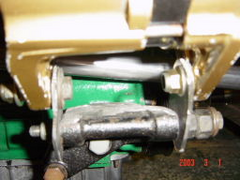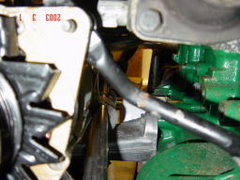
Alternator DOHC Sierra engine
josty - 3/8/04 at 11:17 AM
Hi folks,
I was wondering if anyone (i.e. PaulBuzz)has already had problem with fitting the DOHC, especially the width due to the alternator. It fits but the
engine is not at the center of the chassis then. I can make a new bracket but putting the engine further backwards is also an option. But this is only
possible when I widen the gearbos tunnel.
Thanks for your help.
(And don't start complaining about the sierra DOHC, I'm aware of all that
 )
)
Joost
(The Netherlands)
James - 3/8/04 at 01:35 PM
There must be an alternator with the same belt fitment that's smaller.
Have a poke around a scrappy!
For example, to my v-belt pulley Pinto I've fitted an alternator from a Bedford Rascal van! 
HTH,
James
EDIT: Alternatives to new alternator: could you fit the alternator to the other side of the engine. Or, could you flip the alternator though 180° and
run it in reverse.
You'll have to come up with new brackets for either option but that shouldn't be too hard.
[Edited on 3/8/04 by James]
josty - 3/8/04 at 01:55 PM
Mmm, some nice ideas James. Is it a problem to run an alternator in reverse direction, although it's AC?
Maybe I get it fixed with only another bracket.
Josty
JohnN - 3/8/04 at 11:01 PM
My chassis is McSorley +442, so the engine bay is wider than a book chassis.
My engine (DOHC) is as far back as possible, 20mm from the bulkhead, the standard alternator is very close to the chassis rail.
I haven't yet decided whether to find a smaller alternator or rig up some separate way of tensioning the existing drive belt, with the alternator
fixed, as close as possible to the engine block
JohnN
twinturbo - 4/8/04 at 07:35 AM
I would be wary of running an alternator in reverse, the brushes may be set at angles to suit rotation.
At the very least a new set of bushes would be needed even on a comutator with 90 degree location of busses.
TT
josty - 4/8/04 at 07:14 PM
OK, thanks for the advise.
I will fit the engine as far as possible to the rear. Probably I will cut off the underside (30 mm) of the gearbox and adapt the oil pan (I don't
know if it's the right term) to lower the engine. Adapting the alternator bracket or fitting it in another way is decided later.
Joost
Jon Bradbury - 4/8/04 at 08:22 PM
I think the trick here is to hack up the cast iron mounting bracket. It's what I have been forced to do on my Robin Hood (which is supposed to be
designed for a DOHC engine). I've then bodged up a nasty set of brackets to hold it up. Nasty, nasty, nasty. Anyway, cutting the iron bracket up
allows the alternator to be rolled about its bottom mount so it is closer to the engine. Finally, a shorter fanbelt (they're available in a range
of sizes) allows the whole thing to work. See below. And by the way, the steering column passes through the fanbelt on mine. You can engineer yourself
round this if you have a pulley from a power steering equipped donor and the space / patience to fit it.
[Edited on 4/8/04 by Jon Bradbury]


Rescued attachment Alternator bracket hackup.jpg
Jon Bradbury - 4/8/04 at 08:26 PM
Here's the staybar. It's actually a part of the donor's bonnet catch mechanism, with some gentle persuasion from the vice. It
isn't adjustable, sadly, but it should suffice to get me through the SVA. <ahem> after which the VX POWER is going in there.... well, soon
enough anyway... <dream dream>.
Do you get the picture? You may not get enough space to fit your chassis but it might stop you from having to move the engine back quite so far.
PS, Here's the staybar. Crap, isn't it? Works, though.
Cheers
JonB


Rescued attachment Staybar.jpg
josty - 4/8/04 at 08:57 PM
Ah, that should be my first try, getting the alternator closer to the engine.
By the way, how did you solve the EFI housing problem (too big)? Did you make another one? I'm thinking of putting the thermostat housing at some
other location. In this way the alternator can be placed at a higher point closer to the engine.
Cheers
Joost
twinturbo - 5/8/04 at 10:13 AM
We call the oil pan the "SUMP"
My EFI plenum will be polished and on show under a nice perspex bubble in the bonnet.
TT
josty - 5/8/04 at 11:38 AM
The 'SUMP', now I remember.

cheers
PaulBuz - 5/8/04 at 07:47 PM
Hi Josty
As u know I have the same engine as u.
However u have basically answered for me in the sugestions that u have posted!.
I have offset my engine to the left, (mostly to give me more pedal room, the alt. clearance was secondary).
The sump & g/box belhousing have been chopped by approx. 3" & the engine is mounted as far back as I could get it , then the tunnel was
fabricated.
I will probobly use a smaller alternator with a made up bracket to give me better clearance below my twin 40,s & manifold setup.
I have hundreds of pics so far, if u need any of a perticular section, just shout!
ATB
Paul
josty - 5/8/04 at 10:23 PM
Yes, I noticed Paul. You have done some nice piece of work!
I have a few questions;
Aren't you worried about the bending forces in the bell housing because of the remove of the bottom engine - bell housing mounts?
What did you do with (or to  ) the thermostat housing?
) the thermostat housing?
My plan is leaving the engine in the middle and position it at about 25 cm (10" ) form the front top rail. My car is left-hand driven so moving
my engine to the right (seen form behind of course) in order to get more pedal box space will reduce my alternator space.
) form the front top rail. My car is left-hand driven so moving
my engine to the right (seen form behind of course) in order to get more pedal box space will reduce my alternator space.
Forgive me if my English is crap..
Bye,
Joost (Holland)
PaulBuz - 6/8/04 at 02:27 PM
Hi Josty
I will weld a flat plate to the bottom of the bellhousing, so there should'nt be a problem.
the themostat housing however is a different matter!!
I am searching at present for a suitable in-line thermostat (without any success I should add).
I think in your situation I would find a small alternator & make up a new bracket arrangement. Don't forget the sierra's alt. was made
to power much more load than we will be asking of it.
.....& I would'nt worry about your english, it's a hell of alot better than my Dutch
Peteff - 6/8/04 at 03:27 PM
I remember my old Renault 5, the original jellymould shape, had an inline thermostat in one of the hoses.
stephen_gusterson - 6/8/04 at 03:51 PM
quote:
Originally posted by Peteff
I remember my old Renault 5, the original jellymould shape, had an inline thermostat in one of the hoses.
and a gear lever that came out of the top of the dashboard and a silencer mounted under the front wing above the wheel?

atb
steve

 )
) 







 ) form the front top rail. My car is left-hand driven so moving
my engine to the right (seen form behind of course) in order to get more pedal box space will reduce my alternator space.
) form the front top rail. My car is left-hand driven so moving
my engine to the right (seen form behind of course) in order to get more pedal box space will reduce my alternator space.